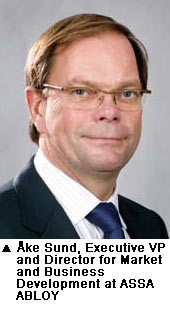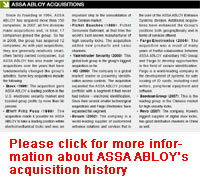Immediately following the merger of Assa and Abloy in 1994, corporate leaders of the new entity set about adopting a three-fold strategy to become the world's preeminent lock provider. Its visible success is why A&S International chose to focus its first Business Talk column on the company's efforts by talking with Ake Sund, Executive Vice President and Director For Market and Business Development.
ASSA ABLOY has seen amazing growth since its start in 1994. A key element of its rapid expansion has always been identifying and building up relationships with potential acquisitions, successfully acquiring them, and equally successfully integrating them into the group. The company has now made more than 150 acquisitions. ASSA ABLOY has evolved from a Swedish-Finnish company to a truly global corporation. With 32,000 employees and sales of more than US$4.63 billion, the group is active in more than 50 countries.
The company's journey can also be described as one from mechanical locks to complete door opening solutions that meet increasing end user demand for personal and physical security as well as user-friendliness. ASSA ABLOY is the single largest player on the market today and is spearheading the trend toward higher security and safety on four continents. ASSA ABLOY aims to continue its proactive acquisition strategy. The market is continuing to grow rapidly due to the new security challenges that society, companies and individuals face in various parts of the world, as well as the opportunities presented by new technology. The security market still consists largely of smaller companies and brands that are strong on their local markets.
This means big opportunities for an expansive global company with the dynamism to adopt new ways of thinking, new technology and efficient production along with new knowledge on the special conditions of local markets.
To further strengthen ASSA ABLOY's market leadership position, the company has, over the years, increased its product and market development resources and efforts to ensure that it is at the forefront of satisfying customer needs to enable profitable growth.
ASSA ABLOY conducts acquisitions for one of three following purposes: To add geographic markets (in recent years, growth markets in Asia have been a strong focus); second is to obtain complementary products to offer customers complete door solutions on established markets; third is to gain access to cutting-edge technologies in specific key fields, such as identification technology.
The companies that ASSA ABLOY acquires are integrated into the group based on specific conditions. This lets them provide added value to customers worldwide through increasingly complete solutions to meet ever-growing security challenges.
The many acquisitions have also fundamentally changed ASSA ABLOY. Through the constant search for new customer needs, technology, markets, cultures and people with new ideas, the company has been able to develop an empowering culture and foster greater openness to the acquired companies and people.
Perhaps, the relative youth of the ASSA ABLOY Group is one of the reasons why the company has not put down roots and is still focused on change and development. The open-mindedness is most clearly shown in the fact that many of the people on ASSA ABLOY's management team came into the company through acquisitions.
Scrutinizing Success
"We tend to see all acquisitions as mergers," said Ake Sund, Executive VP and  Director for Market and Business Development at ASSA ABLOY, and the company has experienced quite a few of them. The preferred approach, he clarified, is to see these types of deals as mergers among equals. "That is part of our success."
Director for Market and Business Development at ASSA ABLOY, and the company has experienced quite a few of them. The preferred approach, he clarified, is to see these types of deals as mergers among equals. "That is part of our success."
In 1994, when Assa and Abloy merged (the only true example), 90 percent of the newly formed company and its operations were based in the Nordic region. Since then, it has purchased roughly 150 companies. One notably significant deal occurred in 2000, when the company bought Yale Group from Williams. "There we acquired 30 companies all at one go," said Sund. "All of these acquisitions involve totally different processes."
The commonalities centered rather on the company's three-part strategy. "From the very beginning, we set out to become the world's leading lock company," said Sund. To achieve these aims, it quickly realized that it needed to have a strong local presence in target markets.
Going Local
"The lock business is very local," said Sund. It involves very strong local brands with local dimensions. That is also true of regulations. Adopting a different approach to enter these markets would have been very difficult; it would have been a challenge to develop the kind of leadership that we wanted within a reasonable time.
The first part of ASSA ABLOY's strategy, therefore, became to buy local leaders. "That is how we became the leading lock group in the world," said Sund. "We have a major presence in every important market, excepting Japan, but even there, we have set up a representative office to map out the market."
He clarified that the company's leadership is not, however, thinking "every day" about acquiring a company in Japan. "It just happens to be the only large market where we have not yet bought a company. It just so happens that we have a disproportionately low presence."
ASSA ABLOY has also been active in many emerging or smaller markets. "Our first years involved creating a presence as a global group," Sund said.
Sund cited India. "While we have had a long-term presence in India, the market is extremely fragmented and underdeveloped. There is no clear market leader that, today, is an obvious target." A similar environment exists in Africa and the Middle East. "We are strong in more developed markets like South Africa, but we continue to invest in growth initiatives in the most important emerging markets," he said.
According to Sund, no one market is more challenging to enter or acquire companies than any other. "We have a successful strategy and we have created excellence in this area. The approach needed to be based on, first, having the right mindset."
Since then, the company's objectives have evolved. Beyond adding companies in geographic areas, ASSA ABLOY started to look at buying companies that would provide complimentary products to its portfolio, noted Sund. "We were looking to fulfill needs for total door opening solutions. That might include door seals, decorative plates, hinges and door controls, really anything that is a vital part of a door opening solution."
The third part of the winning strategy was to add technologies. "Electronic products are becoming more and more important; they are the fastest-growing product segment," said Sund, while pointing out that most sales still involve mechanical locks. There has been, he continued, major growth in electronic door devices and an increased demand for secure identity solutions both for physical and logical access control, which attracted the company's interest.
"We have purchased companies with the technologies that can give us a market leading position in this area." One noteworthy example was the acquisition of HID in 2000. "It is a global leader in access control" said Sund. Another important purchase was that of Besam in 2002.
"As we were expanding on HID's successful business in access control, we realized that a major requirement was to secure the issuing of credentials and cards among others," explained Sund. This led to the company's buyout of Fargo Electronics in 2006. "It was the leading company within printing technology and the development of systems for safe issuing of ID cards, including card writers, peripheral equipment and software."
Given that ASSA ABLOY's range extends throughout the world, it has shifted its attention to adding products to provide complete solutions, especially in mature markets.
Sund remains cautious about biometric technology. "I understand that, for sure, there is a following," he said, "but so far there has been more talk than reality. We have, however, some cooperative ventures in this field. In fact, we follow all technologies, initiating partnerships when required."

This three-fold strategy has become the "guiding star" for all five of ASSA ABLOY's divisions: the EMEA, Americas, Asia-Pacific, Global Technologies and Entrance Systems. "Each division," said Sund, "has its own responsibilities when it comes to acquisition targets and fulfilling such deals."
He pointed out that ASSA ABLOY has "robust corporate governance," but it is really the divisions that are the owners and that drive the acquisition processes within the corporate framework.
While much has been said about the company's acquisitions, what about spinoffs or selloffs? "This has happened in a few occasions," said Sund. "where some parts of companies that we have bought were not of interest to us. Yet, we still had to take them on as part of the deal structure."
According to Sund, the company has had a very clear understanding of what fits and what does not. One example was Effeff. "The Germany-based company was the global leader in electronic strikes used in access control and that was our interest," said Sund. "Yet, half the company's turnover was coming from alarm systems, which did not fit into our Group strategy."
The seller, however, wanted the deal to encompass the whole company and all its divisions. Later, it found a buyer (Caradon, later Honeywell), which saw the value of the alarm business. "That is a natural, if not always easy, process that eventually creates a win-win result," said Sund. "We gain by selling companies that are not of direct relevance to ASSA ABLOY. The buyers win by getting something that they want. Last, the people in the organization get a new owner that is truly engaged in their core business."